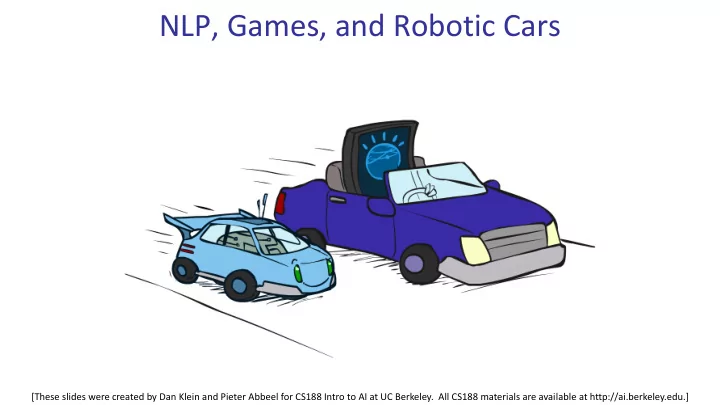

NLP, Games, and Robotic Cars [These slides were created by Dan Klein and Pieter Abbeel for CS188 Intro to AI at UC Berkeley. All CS188 materials are available at http://ai.berkeley.edu.]
So Far: Foundational Methods
Now: Advanced Applications
Natural Language Processing
What is NLP? Fundamental goal: analyze and process human language, broadly, robustly, accurately… End systems that we want to build: Ambitious: speech recognition, machine translation, information extraction, dialog interfaces, question answering… Modest: spelling correction, text categorization…
Problem: Ambiguities Headlines: Enraged Cow Injures Farmer With Ax Hospitals Are Sued by 7 Foot Doctors Ban on Nude Dancing on Governor’s Desk Iraqi Head Seeks Arms Local HS Dropouts Cut in Half Juvenile Court to Try Shooting Defendant Stolen Painting Found by Tree Kids Make Nutritious Snacks Why are these funny?
Parsing as Search
Grammar: PCFGs Natural language grammars are very ambiguous! PCFGs are a formal probabilistic model of trees Each “rule” has a conditional probability (like an HMM) Tree’s probability is the product of all rules used Parsing: Given a sentence, find the best tree – search! ROOT S 375/420 S NP VP . 320/392 NP PRP 127/539 VP VBD ADJP 32/401 …..
Syntactic Analysis Hurricane Emily howled toward Mexico 's Caribbean coast on Sunday packing 135 mph winds and torrential rain and causing panic in Cancun, where frightened tourists squeezed into musty shelters. [Demo: Berkeley NLP Group Parser http://tomato.banatao.berkeley.edu:8080/parser/parser.html]
Dialog Systems
ELIZA A “psychotherapist” agent ( Weizenbaum, ~1964) Led to a long line of chatterbots How does it work: Trivial NLP: string match and substitution Trivial knowledge: tiny script / response database Example: matching “I remember __” results in “Do you often think of __”? Can fool some people some of the time? [Demo: http://nlp-addiction.com/eliza]
Watson
What’s in Watson? A question-answering system (IBM, 2011) Designed for the game of Jeopardy How does it work: Sophisticated NLP: deep analysis of questions, noisy matching of questions to potential answers Lots of data: onboard storage contains a huge collection of documents (e.g. Wikipedia, etc.), exploits redundancy Lots of computation: 90+ servers Can beat all of the people all of the time?
Machine Translation
Machine Translation Translate text from one language to another Recombines fragments of example translations Challenges: What fragments? [learning to translate] How to make efficient? [fast translation search]
The Problem with Dictionary Lookups 16
MT: 60 Years in 60 Seconds
Data-Driven Machine Translation
Learning to Translate
An HMM Translation Model 20
Levels of Transfer
Example: Syntactic MT Output [ISI MT system output] 24
Starcraft
Starcraft
What is Starcraft? Image from Ben Weber
Why is Starcraft Hard? The game of Starcraft is: Adversarial Long Horizon Partially Observable Real-time Huge branching factor Concurrent Resource-rich … No single algorithm (e.g. minimax) will solve it off-the-shelf!
Starcraft AIs: AIIDE 2010 28 Teams: international entrants, universities, research labs…
The Berkeley Overmind Search: path planning CSPs: base layout Minimax: targeting Learning: micro control Inference: tracking units Scheduling: resources Hierarchical control http://overmind.eecs.berkeley.edu
Search for Pathing [Pathing]
Minimax for Targeting [Targeting]
Machine Learning for Micro Control [RL, Potential Fields]
Inference / VPI / Scouting [Scouting]
AIIDE 2010 Competition
Autonomous Driving
Grand Challenge 2005: Barstow, CA, to Primm, NV 150 mile off-road robot race across the Mojave desert Natural and manmade hazards No driver, no remote control No dynamic passing
[Video: Race, Short] Autonomous Vehicles [VIDEO: GC Bad] Autonomous vehicle slides adapted from Sebastian Thrun
An Autonomous Car E-stop 5 Lasers GPS Camera GPS compass Radar 6 Computers Control Screen Steering motor IMU
Actions: Steering Control Steering Angle (with respect to trajectory) Error
Laser Readings for Flat / Empty Road 3 2 1
Laser Readings for Road with Obstacle D Z
Obstacle Detection Trigger if | Z i - Z j | > 15cm for nearby z i , z j Raw Measurements: 12.6% false positives
Probabilistic Error Model GPS GPS GPS IMU IMU IMU x t x t+ 1 x t+ 2 z t z t+ 1 z t+ 2
HMMs for Detection Raw Measurements: 12.6% false positives HMM Inference: 0.02% false positives
[VIDEO: lidar vision for a car] Vision for a Car
Urban Environments
Recommend
More recommend